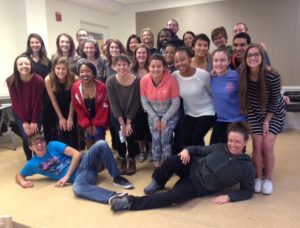J-Term: Gender-Based Violence
This next installment in the J-Term series has been written by Lisa Speidel, Women, Gender and Sexuality Studies faculty. See the other J-Term blogs here.
January 2017 marked the fourth January that I had the honor of teaching the J-term course Gender-Based Violence. I have taught many different kinds of classes in my career such as USEMs with 18 first year students, summer institutes for teachers, 60 students in one of my Women, Gender and Sexuality classes, and groups of women at Memorial gym striking pads and yelling “NO!” as they learn self-defense. However, nothing compares to teaching this J-term course. The intense structure of 5 hours a day over 10 days– with 25 students in animated discussions, listening to lectures, critiquing guest speakers, continuously grappling with the realities of violence–creates connections, a unique community and, ideally, a personal investment in working towards social change.
Gender-based violence often conjures up the image of women experiencing various forms of physical violence, particularly sexual or domestic violence. There is a movement to address this issue in a more gender-neutral tone, since both men and women can be victims of this kind of violence, and I am often asked why we even use the term “gender-based”. Originally the term evolved as a replacement to “violence against women” in an attempt to emphasize the gendered nature of both the victim and the perpetrator. It is estimated that women disproportionately experience violence (for example, 1 in 4 women will experience sexual violence in her lifetime, where estimations for men vary from 1 in 9 to 1 in 12). It is also estimated that 98% of perpetrators are male, regardless of the gender identity of the victim. These statistics alone show a gendered element is present; however, in more recent years an expansion of the definition includes violence based on bias against people not conforming to dominant culture’s accepted gender roles. In addition, definitions have become more inclusive of not just physical violence, but psychological, economical and socio-cultural violence.

In order to address the magnitude and complexities of this subject and the long daily hours of the J-term structure, I divide the class time with speakers from the Charlottesville and U.Va. community. This includes educators from the Sexual Assault Resource Agency, The Albemarle/Charlottesville Domestic Violence Community Service Coordinator, Charlottesville Police Officers, U.Va. Sexual Assault Nurse Examiners, staff from The U.Va. Women’s Center, advocates from The Virginia Anti-Violence Project in Richmond, the U.Va. Program Coordinator for Prevention, U.Va. peer educators, and anti-violence activist, professor and author Chris Kilmartin from Mary Washington University. Instead of only focusing on the problem, the second half of the class entails an analysis of both historical and present violence prevention efforts. We examine the criminal justice system , “risk reduction” strategies, the Public Health Model, consent campaigns, social media, poster campaigns, healthy relationships and sexuality education, peer education, and bystander intervention. Students then work on a group project presentation to critique one of these models, review what perspectives may be missing in these efforts and create a more inclusive, intersectional approach to ending gender-based violence.
Given the personal nature of gender-based violence, it is not an easy task to spend five hours a day immersed in this issue. Whether someone witnessed violence at the hand of a parent, was bullied on the street for being gender nonconforming, is a survivor of domestic violence, sexual assault or emotional abuse, or has been sexually harassed at work or on the street, most people in the class have experienced at least one form of violence. This is an issue for all of us, regardless of gender identity. The J-term structure enables people to build relationships to support each other during learning in this condensed manner. In addition, readings outside the classroom, written analysis and daily reflective writing in their journals at the end of each class allows for time to process the content.
One of my main goals of this course is for the students to put theory into practice and to think about their own role in enacting social change around violence. This can be any form of social action, no matter how small or how large. I hope to achieve what one student stated in his final reflection (and gave me permission to post here):
First off I would like to take the time to mention that this class was one of, if not the best classes I have taken at the University. The open and trustful atmosphere is one that I have personally never experienced and I am thankful for that……I feel like this class was one that was highly necessary for my development as a person….I always believed myself to be an open-minded individual and willing to grow, this class has put me up to that task. Too often people are discouraged from becoming the change they want to see happen…..Most importantly, however, we cannot wait for other people to take action for us, instead we have to hold ourselves accountable and ask whether we are doing our part in the struggle for true justice and equality in our society. Even the issue of gender based violence which seems so specific is so multifaceted that it takes small steps before one can truly begin getting to the core of the problem and addressing it……This class has prepared me and given me tools to identify these issues when I see them as well as giving me some guidance on how to deal with said issues.
By the end of the course I try to impart on the students the philosophy of one of my favorite quotes: “If you ever think you are too small to make a difference, try sleeping in a room with a mosquito”. The J-term experience allows for a personal investment like no other course I have taught, and I am grateful for the opportunity to be involved in a collective learning and teaching environment for both myself and the students.
- Having a Drink With Your Donkey: The Absurd in Antiquity
- What Happens to UVA’s Recycling? A Behind the Scenes Look at Recycling, Composting, and Reuse on Grounds
- Finding Your Center: Using Values Clarification to Navigate Stress
- UVA Club of Atlanta: Virtual Pilates Class
- UVA Club of Fairfield/Westchester: Cavs Care - Food Pantry Donation Drive
- UVA Club of the Triangle: Hoo-liday Party
